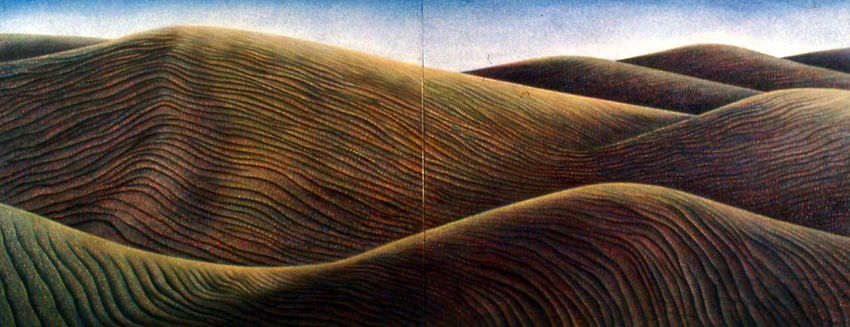
PART ONE DUNES 1970-1996
In this exhibit we start with her most “recent” paintings on the theme of Dunes. I put “recent” in quotes because Yuko stopped painting around 20 years ago when she opened her art center. The very last dune series Yuko worked on was “Spectrum Planet Dune” series which consists of 9 paintings (84” x 60” ), spreading horizontally along a 63 foot length with the spectrum colors in order from left to right: Black, Purple, Indigo, Blue, Green, Yellow, Orange, Red and White. Since she had already done the imaginative Earthy Dune Series, the four seasons “A Quartet Dune Series,” and also the “Planet Dune Series,” she was challenged by the idea of the “Spectrum Color Dune Series” since she is a painter always dealing with the spectrum of colors on her palette. Yuko’s subject matter gradually transitioned from her stone series to imaginative dunes and she continued to use the dotting technique in this next phase. This transition was a very natural step just as since, in natural weathering process, stone transforms into pebbles and eventually and naturally to grains of sand, forming dunescapes. In her stone work, Yuko used the “dot” technique only on the surface of the stones, leaving the atmospheric background plain with no “dot” texture. But when she started the dune series, she applied dots not only to the dune images, but also to the atmosphere in the overarching sky. She realized that since atmosphere is in fact composed of millions of invisible molecules, it was therefore appropriate to express that molecular quality of the atmosphere with numerous dots, and that this also helped bind the entire surface of the painting together. Yuko went on to say, “…by painting innumerable dots with complimentary colors side-by-side, optical repulsion and fusion elicit a tension and excitement in the eye and mind. The dunes’ undulating surface, like ocean waves, dissolving and reforming, evoke a sense of uneasiness which is enhanced and held together by the precisely controlled use of dots, creating a poetic lyrical quality. The concept has to do with the substratum of life itself, eternal newness and change, all at once and together one, the parts and process creating a monumental whole. For in Zen, all is one thing, even the multiform transformational dualism of Western thinking.” The scale of the work is as important as the technique itself. The paintings are large enough so that the viewer standing before the work can actually feel himself or herself in the physical presence of the dune landscape, though imaginary. It is almost a virtual reality done without the use of goggles and computers. Monet’s water lilies have the same effect although done with a totally different “impressionist” technique.